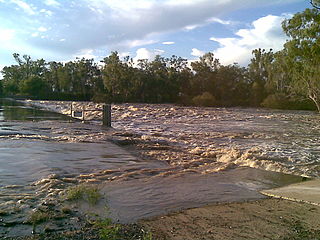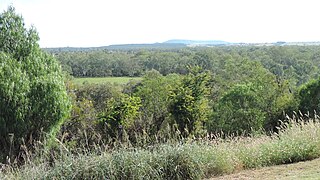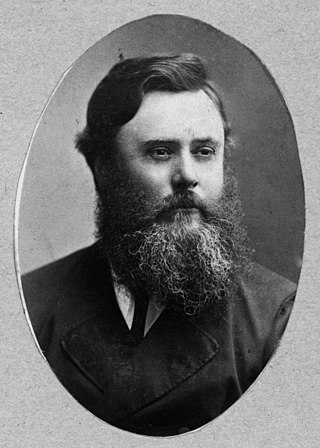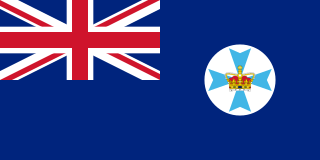Related Research Articles

The Queensland Police Service (QPS) is the principal law enforcement agency responsible for policing the Australian state of Queensland. In 1990, the Queensland Police Force was officially renamed the Queensland Police Service and the old motto of "Firmness with Courtesy" was changed to "With Honour We Serve". The headquarters of the Queensland Police Service is located at 200 Roma Street, Brisbane.

The Dawson River is a river in Central Queensland, Australia.

Taroom is a town in the Shire of Banana and locality split between the Shire of Banana and the Western Downs Region in Queensland, Australia. In the 2021 census, Taroom had a population of 885 people.

James Davis was a Scottish-born convict notable for escaping custody in Australia and living with Aboriginal people for thirteen years.

Thomas Petrie was an Australian explorer, gold prospector, logger, and grazier. He was a Queensland pioneer.

Wandoan is a town and locality in the Western Downs Region, Queensland, Australia. It was formerly known as Juandah. It is on the Leichhardt Highway about halfway between Taroom and Miles and is the centre for the local cattle industry. In the 2021 census, the locality of Wandoan had a population of 666 people.

Australian native police were specialised mounted military units consisting of detachments of Aboriginal troopers under the command of White officers appointed by colonial governments. These units existed in various forms in colonial Australia during the nineteenth and, in some cases, into the twentieth centuries. From temporary base camps and barracks, Native Police were primarily used to patrol the often vast geographical areas along the colonial frontier in order to conduct raids against aboriginals or tribes that had broken the law and punitive expeditions against Aboriginal people. The Native Police proved to be a brutally destructive instrument in the disintegration and dispossession of Indigenous Australians. Armed with rifles, carbines and swords, they were also deployed to escort surveying groups, gold convoys and groups of pastoralists and prospectors.
The Forrest River massacre was a massacre of Indigenous Australian people by a group of law enforcement personnel and civilians in June 1926, in the wake of the killing of a pastoralist in the Kimberley region of Western Australia.
The Hornet Bank massacre was the killing of eleven British settlers, which included eight members of the Fraser family, by a group of mostly Yiman Indigenous Australians. The massacre occurred at about one or two o'clock in the morning of 27 October 1857 at Hornet Bank station on the upper Dawson River near Eurombah in central Queensland, Australia. It has been moderately estimated that 150 Aboriginal people succumbed in subsequent punitive expeditions conducted by Native Police, private settler militias, and by William Fraser in or around Eurombah district. Indiscriminate shootings of "over 300" Aboriginal men, women, and children, however, were reportedly conducted by private punitive expedition some 400 kilometres eastward at various stations in the Wide Bay district alone. The result was the near-extermination of the entire Yiman tribe and language group by 1858; this claim was disputed, however, and descendants of this group have recently been recognised by the High Court of Australia to be the original custodians of the land surrounding the town of Taroom.

The Wandoan Branch is a 70 km railway line in the Darling Downs region Queensland, Australia. It links the towns of Miles and Wandoan. It was approved to extend to Taroom, but construction halted during World War I and never recommenced. The line is now closed.

The Colony of Queensland was a colony of the British Empire from 1859 to 1901, when it became a State in the federal Commonwealth of Australia on 1 January 1901. At its greatest extent, the colony included the present-day State of Queensland, the Territory of Papua and the Coral Sea Islands Territory.

Eurombah is a rural locality split between the Shire of Banana and the Western Downs Region, Queensland, Australia. In the 2021 census, Eurombah had a population of 100 people.

The Fraser family grave site and memorial at Hornet Bank is a heritage-listed cemetery and memorial at Hornet Bank Station, Hornet Bank Road, Eurombah near Taroom, Shire of Banana, Queensland, Australia. It was added to the Queensland Heritage Register on 18 September 2008.
The Yiman, also known as Yeeman, Eoman or Jiman, and by themselves in modern times as Iman, are an Aboriginal Australian people living in the Upper Dawson River region around Taroom of eastern Central Queensland.
Grosmont is a rural locality in the Western Downs Region, Queensland, Australia. In the 2021 census, Grosmont had a population of 135 people.

George Poultney Malcolm Murray or simply G.P.M. Murray was a British-born senior officer in both the paramilitary Native Police and civilian Queensland Police Force.
Woleebee is a locality in the Western Downs Region, Queensland, Australia. In the 2021 census, Woleebee had a population of 62 people.
Beilba, sometimes referred to as Beilbah or Bielbah, was an Indigenous Australian resistance fighter from the Expedition Range area of what is now known as Queensland. He became famous for being a leader in the Hornet Bank massacre of 1857, where Aboriginal forces killed 11 British settlers.
John Fahy, also known as Gilburri, was an escaped Irish convict who lived with the Wakka people of the South Burnett in Queensland, Australia.
Baulie, also known as Bally, Boney or Bahlee, was an Indigenous Australian resistance fighter best known for being a leader in the 1857 Hornet Bank massacre of British settlers near Taroom in what is now rural Queensland.
References
- 1 2 3 4 5 "WILD TOBY Versus THE WORLD". Mail (Adelaide, SA : 1912 - 1954). 22 December 1951. p. 4. Retrieved 22 April 2021.
- ↑ "Murder of Constable Dwyer". The Western Champion . Vol. IV, no. 192. Queensland, Australia. 16 February 1883. p. 4. Retrieved 25 April 2021– via National Library of Australia.
- ↑ "DEATH CHOSE AN IRONIC DATE". Smith's Weekly . Vol. XIX, no. 41. New South Wales, Australia. 11 December 1937. p. 8. Retrieved 25 April 2021– via National Library of Australia.
- ↑ "TAROOM". Dalby Herald And Western Queensland Advertiser . Vol. IX, no. 478. Queensland, Australia. 21 November 1874. p. 2. Retrieved 25 April 2021– via National Library of Australia.
- 1 2 3 4 Reid, Gordon (1982). A Nest of Hornets. Melbourne: Oxford University Press.
- 1 2 "Vale, Senior-Sergeant Wright". The Bundaberg Mail And Burnett Advertiser . No. 1891. Queensland, Australia. 8 April 1898. p. 3. Retrieved 25 April 2021– via National Library of Australia.
- 1 2 "FROM THE VAULT – The murder of Constable William Dwyer, January 26, 1883". myPolice Museum. 21 May 2013. Retrieved 25 April 2021.